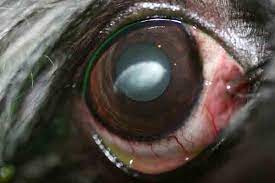What is the thyroid gland and what does it do?
The thyroid gland is one of the most important glands in the body. It is located in the neck near the trachea or “windpipe” and has two lobes, one on each side of the trachea. The thyroid gland is controlled by the pituitary gland, which is located at the base of the brain.
“If the thyroid is overactive (hyperthyroidism), the body’s metabolism is elevated. If it is underactive (hypothyroidism), the metabolism slows down.”
什麼是甲狀腺?
甲狀腺是體內最重要的腺體之一。它位於頸部靠近氣管的位置,它的結構包括兩塊葉,氣管兩側各一塊。甲狀腺由位於大腦底部的腦下垂體控制。如果甲狀腺過度活躍,身體的新陳代謝就會升高。如果它不活躍、功能減退,新陳代謝則會減慢。
What causes hypothyroidism?
In the dog, hypothyroidism is usually caused by one of two diseases: lymphocytic thyroiditis or idiopathic thyroid gland atrophy.
These two causes of hypothyroidism account for more than 95% of the cases in dogs. The other five percent are due to rare diseases, including cancer of the thyroid gland.
甲狀腺功能減退症是什麼原因造成的?
在狗隻中,甲狀腺功能減退主要是由兩種疾病之一所引起:淋巴細胞性甲狀腺炎或特發性甲狀腺萎縮。這兩種原因導致的甲狀腺功能低下症佔犬類甲狀腺功能低下症病例的 95% 以上。另外5%是由罕見疾病引起的,包括甲狀腺癌。
What are the clinical signs?
When the metabolic rate slows down, virtually every organ in the body is affected. Most dogs with hypothyroidism have one or more of the following symptoms:
- Weight gain without an increase in appetite
- Lethargy and lack of desire to exercise
- Cold intolerance (gets cold easily)
- Dry, dull hair with excessive shedding and flaking OR a very thin to nearly bald hair coat
- Increased dark pigmentation in the skin
甲狀腺功能減退症的臨床症狀有哪些?
當新陳代謝速度減慢時,身體幾乎每個器官都會受到影響。大多數患有甲狀腺功能減退症的狗有以下一種或多種症狀:
- 食慾依舊但體重增加
- 嗜睡且缺乏運動的慾望
- 不耐冷
- 頭髮乾燥、暗淡、過度脫落和剝落,或毛髮非常薄至幾乎禿毛
- 皮膚色素沉澱增加

- Increased susceptibility and occurrence of skin and ear infections
- 頭髮生長不足導致掉毛和黑色素沉澱

- Failure to re-grow hair after clipping or shaving
- High blood cholesterol
- Slow heart rate
- 皮膚和耳朵較容易感染或發炎
- 修剪或剃毛後毛髮無法重新長出
- 高血膽固醇
- 心率緩慢
Some dogs also have other abnormalities such as:
- Thickening of the facial skin so they have a “tragic facial expression”
有些狗還有其他異常,例如:
- 臉部皺紋增厚導致“悲慘表情”

- Abnormal function of nerves causing non-painful lameness, dragging of feet, lack of coordination, and a head tilt
- Loss of libido and infertility in intact males
- Lack of heat periods, infertility, and abortion in females
- Fat deposits in the corneas of the eyes
- 神經功能異常導致無痛性跛行、腳步拖拉、缺乏協調性和頭部傾斜
- 公犬性慾喪失與不孕症、母犬缺乏發情期、不孕症及流產
- 眼角膜有脂肪沉積導致角膜內的白色沉積物

- Keratoconjunctivitis sicca (KCS) or “dry eye” due to lack of proper tear production
- 減少淚液分泌而導致乾燥性角結膜炎 (KCS) 或“乾眼症”、
How is it diagnosed?
The most common screening test is a Total Thyroxin (TT4) level. This is a measurement of the main thyroid hormone in a blood sample. Definitive diagnosis is then made by performing a Thyroid panel, which as well as the TT4 includes a Free T4 and TSH analysis.
TT4 can be depressed by multiple diseases, as well as drugs, the resulting diagnosis is known as Euthyroid Sick Syndrome and should be differentiated from true hypothyroidism by your vet
如何診斷甲狀腺功能減退症?
最常見的初步篩查測試是總甲狀腺素 (TT4) 水平。這是對血液樣本中總甲狀腺激素的測量。然後透過進行詳細的甲狀腺的驗血檢查來做出明確診斷,該檢查以及 TT4 包括遊離 T4 和 TSH 分析。 TT4 也可能因多種疾病和藥物而降低分泌,由此產生的診斷稱為甲狀腺功能正常病態綜合症,並非甲狀腺功能本身的異常。
Can it be treated?
“YES”
Hypothyroidism is treatable but not curable. It is treated with oral administration of thyroid replacement hormone. This drug must be given for the rest of the dog’s life.
可以治療嗎?
“可以”
甲狀腺功能減退症可以治療,但無法痊癒。以口服甲狀腺替代身體製造不夠的荷爾蒙。這種藥物必須在狗的餘生中使用。
How is the proper dose determined?
All dogs are started on a standard dose of thyroid replacement hormone, based on the dog’s weight. After 3-4 weeks of treatment, a blood sample is taken to verify that the thyroid hormone levels are normal.
Since the dog’s tolerance of the thyroid replacement hormone may change over time, the dose may need to periodically adjusted. Thus, it is usually necessary to retest TT4 levels every six months. Close communication with your veterinarian is necessary in order to ensure that your dog is neither over nor under-dosed.
If there are any further questions please do not hesitate to call us !
2711 0332
如何調整藥物的劑量?
所有狗狗都要開始服用根據體重標準的甲狀腺替代激素劑量。開始治療 3-4 週後,我們需要再次採集血液樣本以確認甲狀腺激素水平是否正常。由於狗狗對甲狀腺替代激素的耐受性可能會隨著時間的推移而改變,因此可能需要定期調整劑量。因此,狗狗通常需要每六個月重新檢測一次TT4水平。為了確保您的愛犬不會用藥過量或用藥不足,您有必要與獸醫保持密切溝通。
如有任何疑問,請隨時致電我們!
2711 0332
